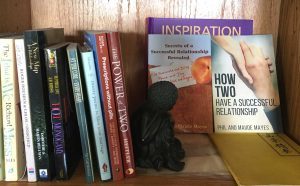Maude Mayes's Blog: Secrets of a Successful Relationship Revealed, page 75
August 19, 2018
The Challenge of Accepting My Partner’s Approach to Illness
 Hi, Maude here. I’ve been facing some challenges to our usually very easy practice of total acceptance in this last period of time.
Hi, Maude here. I’ve been facing some challenges to our usually very easy practice of total acceptance in this last period of time.
What is this issue that has been so difficult for me? Healthcare and how Phil and I differ on how to deal with illness. On the surface, this would seem like any other difference that we could just deal with by finding mutual solutions, by communicating our feelings, and by our easy trust of each other that leads to total acceptance.
But this hasn’t worked with this one, and it has brought up for me all kinds of feelings that are difficult and very charged.
Neither Phil or I have been sick very often. We have been blessed, but I also know that with maturing age, we will be facing this more and more.
When I am ill, I bring everything I know to bear to combat the problem. I get information if I don’t already have it, I apply all methods available to conquer the illness, boost my immune system, and get me back to functioning at top level. I have worked in healthcare from many angles and am reasonably well informed. I’m not saying I don’t allow my body to rest and recuperate, as I do, but I also work toward my health diligently.
When Phil is ill (sorry, couldn’t resist), he beds down to wait it out, grin and bear it, so to speak. He pretty much refuses to take anything or do much of anything. He greets suggestions with refusal and will growl about it being his body and pushes back quite strongly against any attempt to offer or push actions to better the situation.
Normally this would be a great example of how people (perhaps genders) handle issues differently and would be a perfect place to apply total acceptance, get out of the person’s way and just accept that they have a different way of doing things than I do.
Well, as I’ve said that didn’t work for me this time.
I had a very dear friend who had many symptoms of not being OK for a long time. His friends and family urged him to get checked, to do something, to check what was going on with him. He refused. And he kept refusing until at one point, the situation became so extreme that he had to be taken to the hospital. There it was found that he was in the end stage of a now fatal illness, one that would probably have been treatable at an earlier time. He fought it then for several years before he passed. I still feel so sad about this. I love him dearly, and I was also angry at him for a long time for not having done something while there was still time to alter the course of the illness. Angry that he was no longer there for me to laugh, love and spend time with. Angry that he abandoned his wife because of what appeared to me as stubbornness or fear.
Total acceptance is realizing what your partner does is not about you, but about who they are #quote
Click To Tweet
And there is the crux of the matter. I was seeing these kinds of refusals to take care as abandonment. All kinds of things around this have come up for me with Phil’s latest illness and his way of dealing with it. I’ve got some heavy issues in this department, with both my parents having died suddenly and several other deep experiences of sudden loss.
As it turns out, this has been a profound learning experience for me. Somehow, while my love is lying here being ill, I was making this all about me. I was getting angry, feeling betrayed, left alone, not cared about etc. etc. etc. And this is where we can really come to understand what total acceptance is about.
It is about realizing that we are each separate and unique people, and what your partner does is not about you, but about who they are. When their actions have consequences for you, then it is important to communicate and to find ways to acknowledge each other’s needs and find mutual solutions, and to act with honor and respect toward each other. But total acceptance is just that. It is totally accepting the other person and trusting them. I am humbled by what this journey has taught me about just that.
August 15, 2018
Successful Relationships Reading Corner
We wrote in this week’s blog on 4 ways to break bad patterns in your relationship by trying something different for a day. Here are some articles with other exercises to improve your relationship.
This One Exercise Can Improve Your Relationship Today “What a lot of people don’t realize is that what they are seeing has to do with where they are looking, and whatever they look at starts to get bigger in their mind. The brain has limited attentional capacity, which means it can only focus on a certain number of things at one time. Once your brain is occupied with something, you start to lose awareness of what else is happening around you.”
Couples Communication Boosters – Top 5 Activities You Must Try “Communication activities for married couples are those exercises that couples can do to improve the way they converse with one another. As these activities take place, communication skills are enhanced and spouses learn to understand one another. Of course words are understood, that is a given, but when communication is improved, spouses learn the meaning behind those words. This includes how their partner feels and why something is being said.”
5 Communication Games Guaranteed to Bring You Closer “The idea of “working on our communication” is usually met with eye rolls, shrugs or even denials of a problem…Communication Is More than Talking…Talking is simply sharing information using words. It is a way to inform another person about a particular thing. It’s important but it is not a stand-alone relationship builder. Stick around and we’ll show you 5 simple games you and your partner can play to exercise your communication skills, deepen your romantic connection, and build a stronger life together.”
August 12, 2018
4 Ways to Break Bad Patterns in Your Relationship
 We write from our direct experience to share how well we work together. When we first saw this, it was a mysterious phenomenon, and we have spent years discussing and analyzing what, exactly, we are doing. Our idea has always been to say that it exists, to create the belief that such a relationship is possible, and let people examine their own lives to see what to change so that they, too, can have this experience.
We write from our direct experience to share how well we work together. When we first saw this, it was a mysterious phenomenon, and we have spent years discussing and analyzing what, exactly, we are doing. Our idea has always been to say that it exists, to create the belief that such a relationship is possible, and let people examine their own lives to see what to change so that they, too, can have this experience.
To offer exercises that we don’t do has always seemed to go against our intention of writing from our experience. But in previous relationships, we have been challenged with how to change patterns, so today we’ll describe some things that we did to try to improve things. The purpose of these is to make things sufficiently different for a while that both people can glimpse a different way to relate. You need to go in with several things.
Both of you have to be on board with this.
Don’t be thinking your partner needs to do all the changing. If the problem is that your partner is a disciplinarian with the children, maybe you need to set boundaries to give them a sense of security.
Be open to exploring and having fun.
Improve your relationship with 4 exercises that switch up your usual patterns! #relationships
Click To Tweet
The first exercise is called “power for the day”. Take two consecutive days. On the first day, one of you has absolute authority, and anything you say goes. Your partner must do as requested, whether it is going to the mall or scrubbing the kitchen floor. On the second day, the roles are reversed.
This exercise is excellent at allowing people to explore their unmet needs and to ask for things that might otherwise be resisted. It is good at rooting out codependency. It also lets you reflect on the consequences of your demands. If I ask for a clean kitchen floor, will I have to mow the lawn the following day? Will this bring out a tit-for-tat energy or a greater awareness of each other’s contributions?
The next few exercises involve changing the words we use. Language is how we understand the world, and by altering the way we speak, we can change our experience of it.
A great way to do this is to only speak in the present tense. This removes the expression of resentments – you didn’t take out the garbage – and commitments – will you give me a ride to the dentist on Tuesday. It’s easy to cheat at this and other verbal exercises because language is so ductile – I am hoping you will make dinner – but try to stay with the spirit of the exercise.
Another exercise you can try is the same as what we do when we are trying to resolve differences: speak in the “I”.
State the issue or problem you are considering. Fully share what you want and what you feel, speaking one at a time until you are done. Avoid using the word “you” (the finger-pointing you); instead, speak personally. Say “I’m cold,” rather than “You pulled the blanket off me.” Here you are saying how you feel, and not what the other person did. By phrasing it this way, two things are different. Firstly, it is no longer an accusation of the other person’s behavior, so it does not provoke a defensive response (“No I didn’t!”) or a counter-attack (“Well, you did that last night.”) It is merely a statement of how the world is for you. Secondly, a statement in the first person is an act of intimacy, a revealing of your self. By speaking about your own feelings, you offer closeness and invite empathy. How Two: Have a Successful Relationship
A final suggestion is to stop speaking altogether and to have a day of silence. This may not work well if one partner has a need to communicate and the other wants to retreat into solitude, but on the other hand, the point of these exercises is to unbalance the existing dynamic, and it is an opportunity for either or both people to be faced with and reflect on their existing positions.
The connection between two people is far more than words. One of us had the online dating experience of exchanging a long series of intriguing emails for weeks before finally meeting. Instant and extreme disappointment ensued. The shock of the difference between words and real life was profound. (This also explains those couples who are really bad for each other but keep coming back together.)
This exercise gives you the opportunity to look at that non-verbal attraction.
We hope you will enjoy playing with some of these and exploring the opportunities that changes in your behavior with each other bring. Be brave! You may think these are a bit scary, but you are more likely to be pleasantly surprised!
August 8, 2018
Successful Relationships Reading Corner
We wrote in this week’s blog on making all your relationships a way to spread peace. Here are some articles on how to build better relationships in your life.
Building and Sustaining Relationships “Every relationship is different, but they all matter. If you smile and say hello to the school crossing guard on your way to work every day, you have formed a relationship. That crossing guard may be the one who will be watching out for your kids or grandchildren when they are old enough to walk to school by themselves. The guard will remember you and your warm smile when escorting your child across the street.”
5 Ways to Build Stronger Relationships “We all have relationships. We have acquaintances, relatives, colleagues, neighbors and probably some friends. However, for a large percentage of us, many of these relationships are simply not fulfilling. They are unfulfilling because they lack real strength; and they lack real strength because they lack real depth.”
5 ways to build a good relationship with anyone “Like most people, I’ve been working on a few new things. I’m doing more public speaking. I’m experimenting with hot yoga. And I’m trying to build better relationships with the people who matter to me. … Robin Dreeke is in charge of the Federal Bureau of Investigation’s elite Counterintelligence Behavioral Analysis Program. Robin combines hard science and years of work in the field to offer practical tips to build rapport and establish trust.”
August 5, 2018
Make All Your Relationships a Way to Spread Peace
 We notice that sometimes when someone’s relationship breaks up, or they are not in a partnership for a long time, they unsubscribe to our newsletter or stop reading it. So we are taking a look today at that mindset and the issues it may encompass.
We notice that sometimes when someone’s relationship breaks up, or they are not in a partnership for a long time, they unsubscribe to our newsletter or stop reading it. So we are taking a look today at that mindset and the issues it may encompass.
Is our path for everybody? How can you use the information we share, whether you are happy or sad, in a partnership or not, struggling through the pain of a breakup or betrayal, or celebrating the passion and support of a mate?
It might seem that we write about relationship, relationship, relationship, yet part of that, of course, involves you as an individual, the act of knowing and growing yourself. What we’re writing about applies to every relationship from family to friends to fleeting contacts.
There is a possibility of meaningful human contact with everyone. There are so often barriers that block this connection, but remove one of them – yours – and sharing is that much more possible. Do this by listening. Hear what they are saying. Their concerns. Their fears. Their needs. Their dreams. Take yourself out of the picture and see them as a character in a movie. Even if they put up a barrier, you can still listen to who they are behind it.
Do you approach everyone with the same love and caring as you would a partner? #relationships #peace
Click To Tweet
We’ve written about core values and how important it is for them to align, so you might think that rules out the possibility of connecting with a large swath of people, but no, you share some basic things with everyone – your humanity and your survival needs. On a physical level, these needs are things like food, shelter, contact, and love. On a mental or emotional level, we crave acceptance, acknowledgment, appreciation and love. On a spirit level, we need peace and love. You have lots in common. Why do people talk about the weather with strangers? (I’m looking at you, Brits.) Because it is a shared experience; it’s raining on both of you at the same time.
Look at your relationships. Look at everyone you know. Do you approach them with the same love and caring as you would a partner? Can you apply our process to finding mutual solutions and decision making in those relationships? Would active listening and being fully present enrich your exchanges with them? Do you approach everyone with the awareness of the potential sacred nature of these communications?
As you learn to know and grow yourself and as you apply this consciousness to your daily interactions, you have an opportunity to experience and spread peace, to learn how to view other personalities as related to you, as fellow travelers in the same family.
So we say again to all of you, we experience peace and a lack of conflict in our relationship. We experience love, passion and creativity. We experience support and comfort and ease which underpin our journey in the world of challenge and adversity. Such things really exist. We state this from direct knowing, and we suggest that the strength and sustenance we get from our relationship can also be found in all relationships. We, as always, invite you to come along with us on this journey. By so doing, you will be spreading peace in the world, one relationship at a time.
August 1, 2018
Successful Relationships Reading Corner
We wrote in this week’s blog on how to blend connection and separation in your relationship, and as usual, we’ve tracked down some other articles on this topic. Enjoy!
Balancing Togetherness and Individuality “Mutuality is one of the most important aspects of marriage success. But how do you become part of a couple while maintaining a strong sense of yourself? How do you manage your need for time together and time apart? And what do you do if you and your partner have different ideas of how much time to spend together? How much time together is enough? Is there such a thing as too much togetherness? Is there a way to maintain closeness even when your work life is especially demanding of your time and attention, perhaps including prolonged separations?”
Time Together vs. Time Apart: Which Is More Important? “How much time should a couple spend together? Apart? That’s the tug and pull of many couples. Too much time together could make one partner feel suffocated. Too much time apart could make one partner feel isolated. So how much time is best? There’s something most couples overlook that I’m going to share.”
Developing a healthy balance between separateness and togetherness in relationships “One family-of-origin theorist, Murray Bowen (1978), developed a theory called ‘differentiation of self’ that is helpful when looking at issues around closeness and separateness in relationships. Research (Skowron, 2000) has shown that couples who demonstrate a higher level of differentiation are more likely to be satisfied in their relationship. On an individual, internal level differentiation of self refers to a person’s ability to distinguish between self and other and between the more rationale and the more emotional parts of our self.”
July 29, 2018
How to Blend Connection and Separation in Your Relationship
This week, Maude has been away each night taking care of the grandchildren, and she recently took one of them up to the Bay area for a week. None of this put a ripple in our relationship. We have a constant ease and comfort with each other.
You might say that this is because we remain connected, as opposed to the feeling of disconnection that can occur when a couple separate, requiring some degree of repair every time they rejoin. Perhaps they have some feeling of abandonment or anxiety or deficiency that has to be assuaged. That’s not us at all.
“How can this be?” we ask ourselves. What is the substance of this transcendent connection? We talked this over before writing this blog, and this is what we came up with. Most couples who share the kind of long-term loving relationships we talk about will know what we are describing. We have a sense of ease and comfort by virtue of being so fully in the relationship.
Our commitment to the relationship paradoxically allows complete freedom #relationships #marriage
Click To Tweet
Commitment
Our commitment to the relationship makes such a life possible. It creates complete trust in each other, and from that, nothing the other person does is unsettling. We have no worries or strain when one of us is elsewhere, even for extended periods. This trust and ease allow each of us to be free and creative and to be out interacting with the world without any sense of stepping away from the relationship. (What makes such commitment possible is a whole other subject; perhaps we’ll cover that some other time.)
Acceptance
We’re cool with what the other person does. We don’t feel a need to control what they do or how they behave. There is no need to check up on each other; no feeling of concern or sense of separation. Our relationship is not founded in neediness. We are each whole individuals without the other, but by choice, we are together and find ourselves greatly added to as a result. We think this is a big deal in relationships, and furthermore, it’s a two-way street, offering complete freedom. How valuable is that? (In our book we call it the 100% factor.) It allows for a rich and colorful life without stepping away from the relationship.
Connection
We feel connected even when apart because we understand each other well. We know what’s going on with each other. We share our hopes, our frustrations, our responses to people, our parking problems. It all adds up to an awareness of what makes the other tick, and that is the path to understanding. We find happiness in the other’s pleasure and fulfillment and do not see our relationship as diminished if our partner is occupied with something else. At the same time, we put time and attention into really being together and always make sure that we share ourselves and experiences often and regularly. We are aware of maintaining balance and communicate any needs that come up.
What are your experiences like? You may not practice exactly what we describe but still have the same result. How do you do it? We share this as always to point out what is possible, and also to stimulate thinking in the direction of what can be improved toward the goal of creating peaceful and working relationships. Won’t you join us?
July 25, 2018
Successful Relationships Reading Corner
This week’s blog is about how to avoid compromise in your relationship. Here are some other writers’ takes on this topic.
How Compromise Is Actually Hurting Your Relationship (And What To Do Instead) “Compromise implies that both people have to give up something they want in order to come up with a solution that is tolerable for both. While this all sounds noble and selfless, I think compromise as a solution may do more harm than good. Viewing compromise as your ideal solution requires that we enter a mindset of need rather than empowerment. We assume all we can get is the bare minimum rather than asking for what we really want. We settle rather than flourish.”
Want a great marriage? Don’t compromise—try this instead “‘Don’t compromise yourself. You’re all you’ve got.’ – Janis Joplin. Janis’s fierce dedication to herself is potent advice. And I can’t think of anyone in need of such fierce dedication more than parents. Speaking from my own personal experience and from the work I do with couples in my couple therapy practice, I can say that the struggle is real. It is so easy to compromise ourselves for our kids or our partners and convince ourselves we’re sacrificing for a greater good. Yet repeatedly doing this can create serious problems down the line.”
Create a Successful Marriage: Don’t Compromise! “‘Compromise—no matter how difficult—is a necessary part of any successful, enduring marriage.’ I emphatically disagree. Not only is compromise NOT a recipe for success in relationships, but compromise is exactly why so many marriages fail. It’s true that we are all very different and that conflict often occurs because of these differences. That’s not going to change—we will always be unique. However, honoring differences and learning to explore what’s important to each other is part of what makes a relationship so rich, exciting, and surprising—and that’s what makes compromise so unappealing.”
July 22, 2018
How To Avoid Compromise in Your Relationship
 “Oh, what I do to keep peace in my relationship!” This was the frequent refrain of a dear friend, and when asked further what he meant by that, he explained “Well it seems I’m always giving something up to keep my partner happy. Often, when we disagree on how or when or where to go or what changes to make, I seem to give up my point of view, or most of what I want, to keep her happy. To be fair, she does the same. It just seems to be a constant tug of war, with one of us the winner and one of us the loser.”
“Oh, what I do to keep peace in my relationship!” This was the frequent refrain of a dear friend, and when asked further what he meant by that, he explained “Well it seems I’m always giving something up to keep my partner happy. Often, when we disagree on how or when or where to go or what changes to make, I seem to give up my point of view, or most of what I want, to keep her happy. To be fair, she does the same. It just seems to be a constant tug of war, with one of us the winner and one of us the loser.”
This experience of compromise is one that many people seem to have; they feel they must give up something to get something else.
Recently we were talking with another friend about our latest book, and she asked us what it is we do rather than compromising in our relationship. She wanted to know if there really is a difference in our approach to solving problems and finding solutions.
Last week we concluded our 3-part article on the Spectrum of Acceptance by discussing how to reach a mutual solution. When we talk about this, people often think we must compromise in some way because they can’t imagine any other way of behaving in a relationship. Surely this is what reasonable people do? They trade off and make sure that over the long run, it balances out so as to be fair to both sides. No! Compromising is giving something up; how can you repeatedly be doing that and still live a fulfilled life? It’s a consequence of a mindset of limited resources and competition between people.
Instead of compromising in your relationship, believe in the unlimited nature of what can be #quote
Click To Tweet
The first element of a different approach is to believe that another way exists. When approaching your mate with the desire to find mutual solutions and decisions, it is very important to be able to delve inside and understand the why of your position. It helps tremendously to work independently on yourself and continue to get to know yourself better. This enhances being able to share your why and wherefore with your love, which in turn adds so much more to the ability to create new and mutual solutions.
When these factors are present, you can have a different and wonderfully satisfying experience. One in which there is no giving up anything, but rather where you come together, pooling what each of you has and co-creating together an outcome that did not exist before.
This place of creating presumes certain basic elements. You are coming from a belief in the unlimited nature of what can be, rather than from an attitude of limited resources and possibilities. When the assumption is that there is only a limited number of choices, then there can’t help but be a struggle for acquiring control, an attitude of competition. When things are approached from a feeling of shortage, this leads to the aspect of compromise which feels like things are being divvied up.
Replace that instead by the ideas that life is cooperation not competition, that there are more possibilities than you’ve thought of, that it’s quite likely that your current choice is not the best there is, and that changing your mind shows adaptability, not weakness. When your partner can play and explore in the same way, it becomes a puzzle game, not a struggle.
Sharing your wants and goals with each other does several things. It often makes your wants clear to you when they were formerly fuzzy. It gives your partner insight into how you feel and changes their relation to the situation. It gives them ideas to work with. It creates intimacy between you.
When you can let go of knowing in advance what you want the outcome to be, and when you can adopt an attitude of non-attachment coupled with mindfulness, then there is no limit to what becomes possible.
In this climate, you can actually partake of the sacred experience of co-creating new and different possibilities for your mutual enjoyment and profound satisfaction. The sense of competition disappears. These shared possibilities are like flashlights in the dark, helping you explore until your paths cross at a place that has no hint of compromise.
July 18, 2018
Successful Relationships Reading Corner
This week’s blog is about how to reach a mutual solution in your relationship. It’s the third of three posts on the spectrum of acceptance. Here are some articles covering how to resolve differences with your partner.
Solve Tough Dilemmas With the Win-Win Waltz This is by Susan Heitler, who we greatly respect for her position on conflicts. “Would you like to resolve all your conflicts without arguing? No more “My way!”, “No my way!” fights? Learn instead the three steps of the win-win waltz. The three steps of win-win waltzing help you to understand each other’s concerns instead of locking into adversarial positions.”
Our Conflict-Free Relationship This is a guest post from us. “Our view on conflict in relationships is radically different from the common one, which holds that conflicts are unavoidable, even important and necessary. In our experience, this is a fallacious assumption that sets up and perpetuates a negative mindset. Couples are primed to expect adversarial exchanges in which they take different sides, creating an illusory separation between them.”
Problem solving – 3 step guide “Don’t let problems tear you apart. Learn from them and use the solution process to help you create an even more intimate and satisfying marriage. While relationship problems are varied and complex, we believe that most relationship problems are by-products of ineffective or counterproductive communication within the relationship”
Secrets of a Successful Relationship Revealed
We use this blog to continue the exploration of the magic that can be found in a relationship, and the wider implications of peace for the world. ...more
- Maude Mayes's profile
- 8 followers





